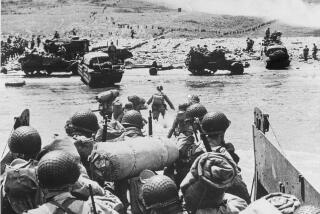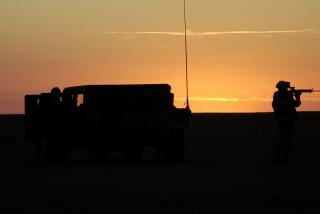‘Saddam Line’ Falls Easily to Marines
- Share via
EASTERN SAUDI ARABIA — Thoughout the desert night, the screaming jets hammered the enemy, some of them raining down fuel-air bombs that turned the skies a grisly orange. Loudspeakers blared, exhorting unseen Iraqi soldiers in Arabic to “surrender before it is too late.” The artillery thundered, firing salvo after salvo.
Then, dressed in protective suits against chemicals, thousands of U.S. Marines launched the long-awaited allied attack into Kuwait on Sunday.
“G-Day,” as the troops dubbed it, had the potential to be a nightmarish spectacle, filled with flaming oil ditches and deadly mists of biological and chemical gas. Iraqi President Saddam Hussein had repeatedly threatened that this was to be “the mother of all battles,” with thousands of casualties.
It did not happen that way, as even the weather cooperated with the allies on Sunday. Unexpectedly this weekend, the wind shifted. Rain fell. The noxious smoke from burning Kuwaiti oil fields that had filled the sky for days, blotting out the sun and blackening the horizon, dispersed on G-Day.
And for the Marines--some of whom had crept across the border on foot on Saturday and used simple plastic pokers to probe for mines on their hands and knees in the dark--the largest U.S. military campaign since World War II started off easily.
Perhaps too easy.
“It’s gone too smoothly,” said the worried Marine commander, Lt. Gen. Walter E. Boomer, about six hours after the first waves of Marines had stormed over the Saudi border at 4 a.m Sunday and quickly breached Iraqi front lines. “Any commander gets concerned in that situation.”
The rain-drenched Marines met only sporadic resistance as they quickly cleared lanes through Iraqi minefields and raced northward throughout the day.
Indeed, the biggest problem by nightfall Sunday was finding enough buses and trucks to ferry the many prisoners they were taking--most of whom surrendered without a fight.
Earlier in the day, as cold rain soaked the desert, and under the protection of heavy artillery fire, an armored and mechanized infantry, the 1st Marine Division task force (called “Ripper”), raced overland. By 6:45 a.m., the troops broke through Iraq’s first line of defense, the “Saddam Line,” 12 miles from the L-shaped heel of Kuwait’s southwest border with Saudi Arabia.
Other Marine task forces, code named “Grizzly” and “Poppa Bear,” launched simultaneous attacks and feints along the border to confuse the Iraqi defenders and mask the major thrust.
The 2nd Division Marines surged across the border at 5:30 a.m. to attack Iraqi positions northwest of the giant Wafra oil fields. They punched holes through the first minefields and defense lines within two hours, according to the division commander, Maj. Gen. William Keys.
The Marines faced scattered artillery and machine-gun fire and detected a “wee little bit” of chemical gas about 10 miles inside Kuwait, Keys said. The gas apparently was released by buried mines, rather than Iraqi artillery, he said.
The initial assault was aimed at a double line of Iraqi fortifications, called the obstacle belts. The first was more than half a mile wide, with multiple rows of antipersonnel and antitank minefields, rolls of razor wire, dug-in infantry positions and pretargeted artillery “kill zones.” A second, similar belt is about five miles farther east.
The 2nd Division roared across the muddy desert flats in six columns of tanks, Bradley Fighting Vehicles, armored personnel carriers and infantry. Special mine-clearing plows and explosive line charges helped blast lanes through the deadly sands of the first line as Marine AV-8B Harriers, A-6 and F/A-18 Hornet attack planes and Cobra helicopter gunships roared overhead for protection.
Moving to the northeast, two columns reported that they had reached the second defensive line inside occupied Kuwait by 7:50 a.m. Two other columns bogged down midway between the two barriers because of an oil pipeline and a heavy concentration of mines.
“On the other side of the barrier, they are putting up stiff resistance,” said Lt. Col. Jan Huly. “They’re offering resistance. They’re fighting.”
Gen. Boomer said he expects heavier fighting, particularly from entrenched Iraqi forces deeper in Kuwait. “The farther we move, the harder the fight will become,” he said.
But by 4:30 p.m., according to one officer, Marine units were halfway to Kuwait city.
The strategy was simple: Keep moving. Advance columns fought only when they had to, bypassing concentrations of Iraqi troops to cut them off or leave them to surrender to follow-up units.
Otherwise, the Marines raced for a series of preplanned targets, said Col. Carl Fulford.
The troops’ mobility also reduced the threat of powerful Iraqi artillery, he added. Without an air force, and little forward ground reconnaissance, Iraqi gunners were forced to fire blind, rendering them largely ineffective against the fast-moving attackers.
The wind also played havoc with the Iraqis. When it shifted and blew away the smoke and haze, it exposed almost 100 camouflaged Iraqi artillery pieces. They were quickly destroyed by allied attack planes. “The weather has changed to our advantage,” said a Marine pilot aboard the Nassau, a command ship for amphibious forces in the Persian Gulf.
The countdown for G-Day began Feb. 10, when a specially trained reconnaissance team of the 1st Marine Division crept across the border to seize prisoners and documents from an Iraqi observation post.
Later, more reconnaissance squads slipped across, hiding for three days to study details of the obstacle belts. One team was nearly discovered when a Marine accidentally stepped on what turned out to be the roof of an underground Iraqi bunker. He quickly moved back when he heard voices underneath, according to a Marine staff officer.
By last week, as artillery assaults and ground raids were launched to deceive Iraqi forces, Marine engineers had cut more than 100 pathways through the six-foot-high sand and stone berms that run parallel to the border. Several teams worked their way through the minefields, barbed wire and barriers of the first obstacle belt.
In a change from the high-tech war of Patriot missiles and Stealth aircraft, the soldiers used low-tech, two-foot-long plastic pegs to probe for mines seeded in the sands.
As the blistering attack continued, a Kuwaiti air force captain who is helping the Marines with psychological operations noted that the invasion to liberate his country came one day before Feb. 25, when Kuwaitis traditionally celebrate their independence from England.
“I will see you in Kuwait,” he told a group of reporters.
This article was based on pool reports cleared by military censors.
More to Read
Sign up for Essential California
The most important California stories and recommendations in your inbox every morning.
You may occasionally receive promotional content from the Los Angeles Times.














